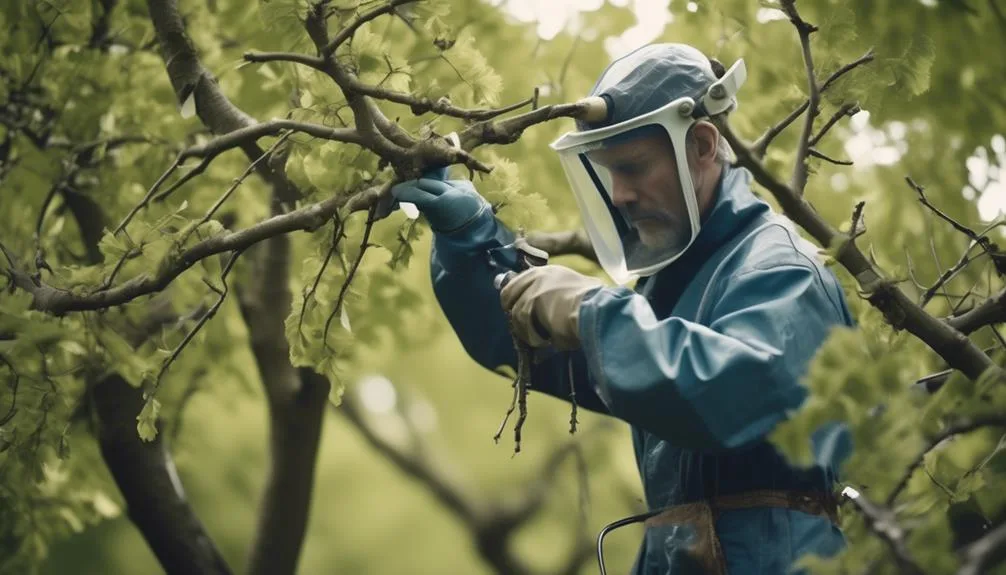Maintaining the beauty of your elm trees requires knowing the best pruning techniques. Proper pruning promotes healthy growth, enhances the tree's shape, and reduces potential risks.
Before you start pruning, it's important to understand the process, including timing, tools, and aftercare. Let's explore the art of pruning elm trees to uncover the secrets of nurturing their splendor.
Timing for Pruning Elm Trees
When pruning elm trees, it's important to regularly assess the timing to ensure optimal health and growth. The best time to prune elm trees is during late winter or early spring while the tree is still dormant. This timing helps to minimize stress on the tree and allows for rapid healing of any pruning wounds.
Seasonal considerations are crucial as well. Avoid pruning in the fall as this can leave the tree vulnerable to disease and insect infestation. Similarly, pruning during the summer months can lead to excessive sap bleeding and make the tree more susceptible to diseases.
Tools Needed for Pruning Elm Trees
To effectively prune elm trees, you'll need a selection of sharp, clean cutting tools designed specifically for tree maintenance. Here are the essential tools you'll need:
- Pruning Shears: Ideal for cutting small branches and twigs.
- Pruning Saw: Used for thicker branches and limbs that are too large for pruning shears.
- Tree Wrap: Helps protect the bark from sunscald and frost cracking, especially in younger trees.
- Tree Wound Dressing: Can be applied to large cuts or wounds to promote healing and prevent disease.
Using the proper tools is crucial for the health and appearance of your elm trees. Remember to prune during the best time for elm trees, and always use the right tools for the job to ensure the best results.
Techniques for Pruning Elm Trees
Consider using a phrasal verb when initiating the pruning process for your elm trees to ensure optimal growth and health. Start by 'cutting back' any dead or diseased branches to promote healthy branch structure and prevent the spread of disease.
When pruning, always make clean cuts just outside the branch collar to aid in quick healing. Additionally, thin out crowded areas to improve air circulation and sunlight exposure. This helps prevent disease and encourages even growth.
Be sure to remove any water sprouts or suckers as they can divert energy from the tree's main branches. By following these techniques, you can maintain the health and vigor of your elm trees while promoting a strong and well-balanced branch structure, ultimately aiding in disease prevention.
Common Mistakes to Avoid When Pruning Elm Trees
After learning proper pruning techniques for your elm trees, it's crucial to be aware of the common mistakes to avoid when maintaining their health and structural integrity.
Here are the common mistakes to avoid when pruning elm trees:
- Improper timing: Pruning during the wrong season can lead to stress and potential damage to the tree.
- Over-pruning: Excessive removal of branches can weaken the tree's structure and lead to stunted growth.
- Ignoring tools maintenance: Dull or dirty tools can cause jagged cuts, making the tree vulnerable to diseases and pests.
- Removing too much foliage: Drastic removal of leaves can hinder the tree's ability to photosynthesize, leading to nutrient deficiencies and weakened immunity.
Avoiding these mistakes is crucial to prevent consequences that could harm the health and appearance of your elm trees.
Aftercare for Pruned Elm Trees
Ensure proper aftercare to support the health and vitality of your pruned elm trees. Maintaining adequate soil moisture is crucial after pruning. Water the trees deeply, ensuring the soil is evenly moist but not waterlogged. This helps the trees recover from the pruning stress and promotes new growth.
Additionally, consider applying a layer of mulch around the base of the trees to help retain soil moisture and regulate temperature. Disease resistance is also important post-pruning. Keep an eye out for any signs of disease or pest infestation, and promptly address any issues that arise. Regularly inspect the trees for any abnormal changes in foliage or bark.
Conclusion
Incorporating these pruning techniques for your elm trees will help ensure their long-term health and vitality.
By pruning in late winter or early spring with sharp tools and proper techniques, you can encourage robust growth while avoiding common mistakes.
Providing the necessary aftercare will further support the thriving of your elm trees.
Happy pruning and nurturing your trees for years to come!

My interest in trees started when I first saw the giant sequoias in Yosemite.
I was a teenager then, and I remember thinking, “I need to learn more about this.”
That moment stuck with me.
A few years later, I went on to study forestry at Michigan Tech.
Since graduating, I’ve worked in a mix of hands-on tree care and community education.
I’ve spent over ten years helping people understand how to plant, maintain, and protect the trees in their neighborhoods.
I don’t see trees as just part of the landscape.
They are living things that make a real difference in our daily lives.
